
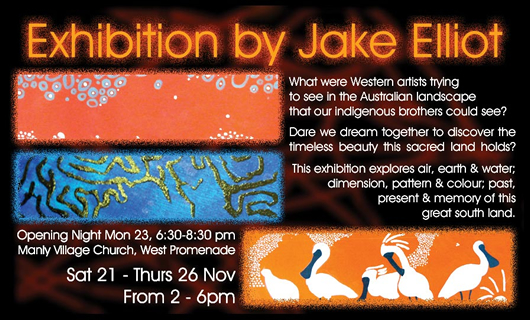
| Home | Saving Faces of God | Dreamtime |
| Dreamtime - Art Works - in More Detail | ||


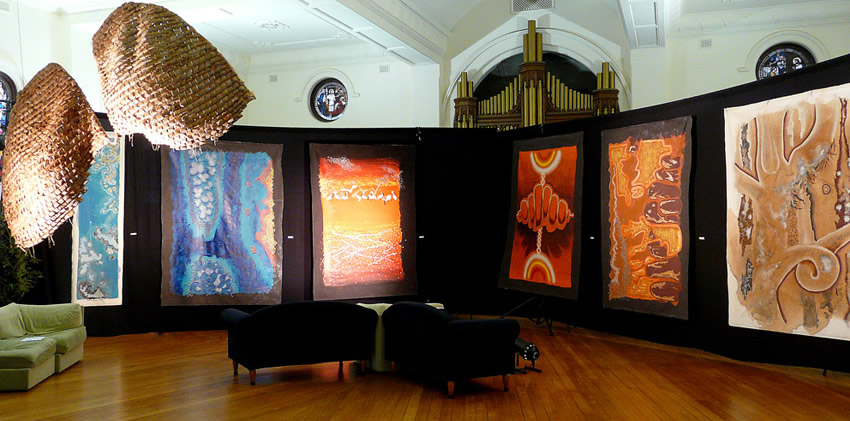
From left to right: Spirit Flight to Dreams,
Corroboree of Origin, Corroboree of Life, Corroboree of Seasons, Corroboree of Heart, Corroboree of Stone, Corroboree of Spirit
The Technical Aspects From a microscopic, telescopic and kaleidoscopic view these paintings tell a dreamtime account of the genesis creation. I did not use any particular aboriginal art references, but certain aboriginal artists inspired me because of the art's relevance in today’s culture. My main references were from Western artists and art styles related to our reconcilation to the land. My concept was connecting and identifying with the land. I looked at bridging the gap between Indigenous and Western art – the land being the source of inspiration. It was my desire to see both through indigenous eyes and those of famous western artists such as Russel Drysdale (uses form, colour and alien landscape to express Australian landscapes), James Gleeson (explores the subconscious and portals from sky to land, land to water, water to sky) and Brett Whitely (great sense of space, great line work). Other artists and styles I researched included Jackson Pollock, John Olsen and Mambo art. This is not aboriginal style art. In my journey to represent the Australian landscape and by trying to see what indigenous people see, I have realised something in common. It is not unusual for the viewer to get a sense of 'aboriginal' art at this exhibition. However, this perception is mainly brought with them through their own experience or idea of what aboriginal art is. Much of my work can been viewed as an aerial perspective or map, is generally 2D, uses Australian colours, uses intricate, repeated patterns (some dots), so there is a connection to 'aboriginal' art. Obviously the names of the works add to this illusion but this is not aboriginal style art. |
My aerial references and perspectives, use of fungi, exploration of repeated patterns (more connected to pixel art and pointillism), exploration of different media, my personal experience of the outback and interest in western art forms, have all combined to represent this land in my own way. For example, in Corroboree of Seasons, the tiny bird patterns are like an aerial view of the flocks of birds and the large white dots show how the late afternoon sun catches the water. In Corroboree of Stone, the Pinnacles are shown vertically rather than horizontally.This gives more of a sense of a map. This simple change already connects it to indigenous art as aboriginal art often represented a map of key features the landscape. In Corroboree of Heart, the Olgas have a Mambo style about them - dominant. As an indigenous lady once told me, "you white people don't know how to sit". I am learning. Having these paintings not framed, added to the rawness of the works - similar to the way Indigenous people paint and show their artworks.
|
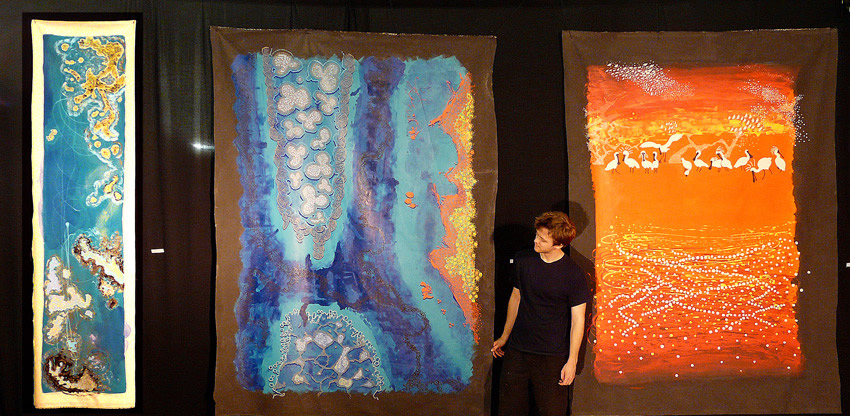
Corroboree of Origin................ Corroboree of Life ............................... Corroboree of Seasons

.........Corroboree of Heart.......................... Corroboree of Stone ............................... Corroboree of Spirit
The following artworks were in the entry way. They help set the tone and introduce one of the themes.
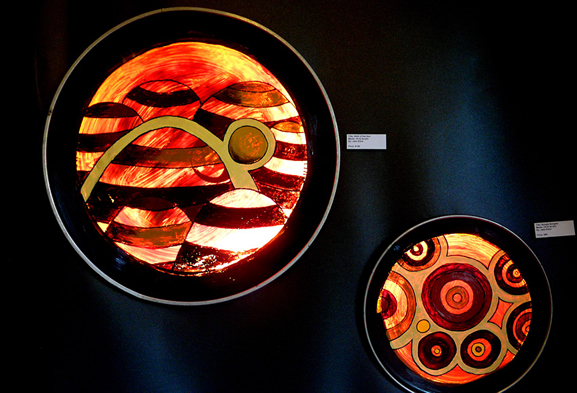 |
(From left to right) Birthing of the Sun (Acrylic and backlighting on drumskin) Bungle Bungles (Acrylic and backlighting on drumskin) The concept and style of these artworks originated as simple doodles while I was travelling through the Bungle Bungles in the Kimberley Region of Western Australia in 2001. These artworks played a huge role in my art process as these doodles helped me tap into my understanding of my subconscious state when I drew them in 2001. At that time, I thought nothing of them. But looking at them now, I observed that they were a style not of my own and that I naturally wanted to draw them from an aerial perspective because I thought it would be 'nice'. This 'nice' state I was in was my subconscious side kicking in as I drew the 'Bungle Bungles'. I naturally wanted to see the land differently for some reason. I can see how my western influences, helped destinguish these pantings from Aboriginal art. I also liked the idea of painting them on drumskins and having light hitting them behind to diffentiate from Aboriginal art. Traditional aboriginal artworks were on stone, bark or wood. I'm using manmade objects and light to make my memory of my outback experience relevant today. I wanted to paint with light to add to the story of the sun exploding with it's brilliance from the Bungle Bungles. |
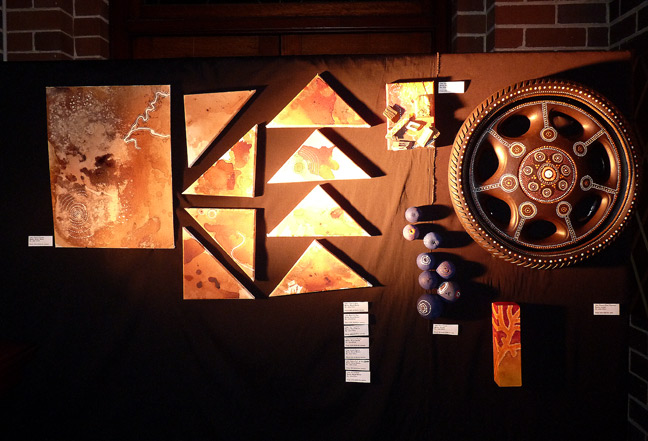 |
In the entry way I sited pieces that merge landscape with the manscape; material with the immaterial. |
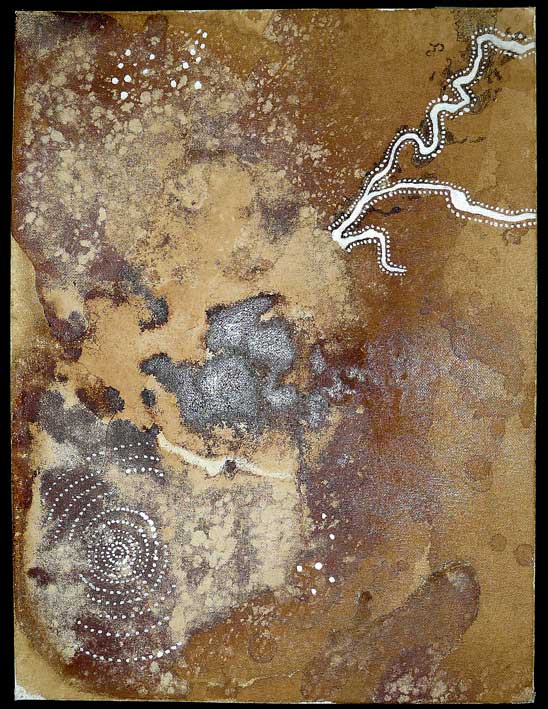 |
(From left-down to right-down) Time's Course, Mixed Media These artworks created with tea, are trying to capture the beautiful browns of outback Australia. Enspired by artists from Broken Hill, I loved the idea of looking down from the sky upon this sunburnt country and capturing the river systems and patterns of this un-inviting landscape. I allowed the tea to dry out in the open weather for a few months and capture that weathered feel of the Australian landscape. With inks, I gave the artwork just enough definition so audiences can link the rust and corrosion of the tea, to the land we live in. Because I feel timelessness in the the Australian outback, I wanted to capture that in this painting, |
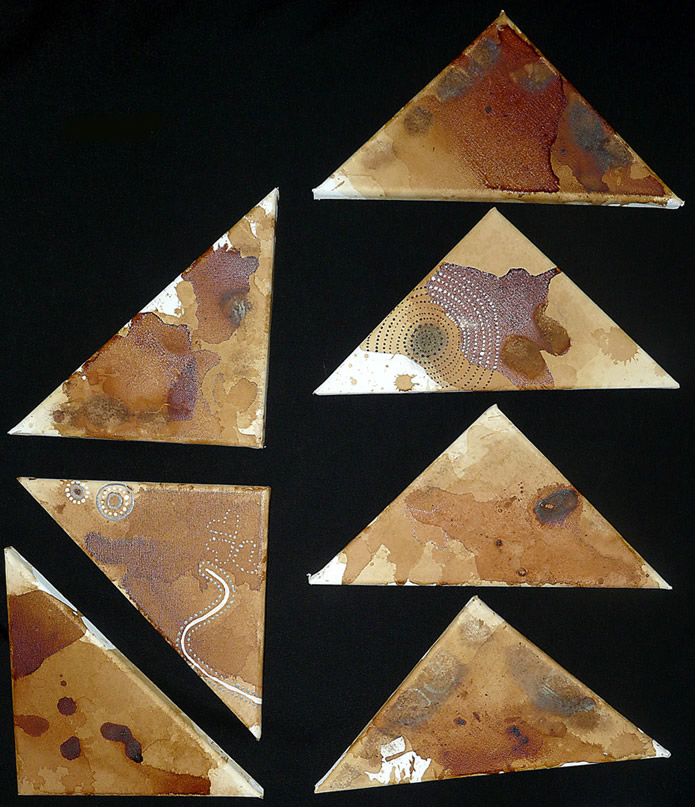 |
(From left-down to right-down) Time to Meet, Tea on Canvas Meet For Tea, Mixed Media Tea Together, Tea On Canvas
Together Dream, Tea On Canvas Dream Space, Mixed Media Space Out, Tea On Canvas Out of Time, Mixed Media Linked with the artwork above, these sub-conscious teascapes explore the connection we have to our land. These too are also weathered to capture the timeless nature of this land. Tea was used to represent how we Westeners met in Corroborree - waited for the billy to boil - when we camped in our native land. |
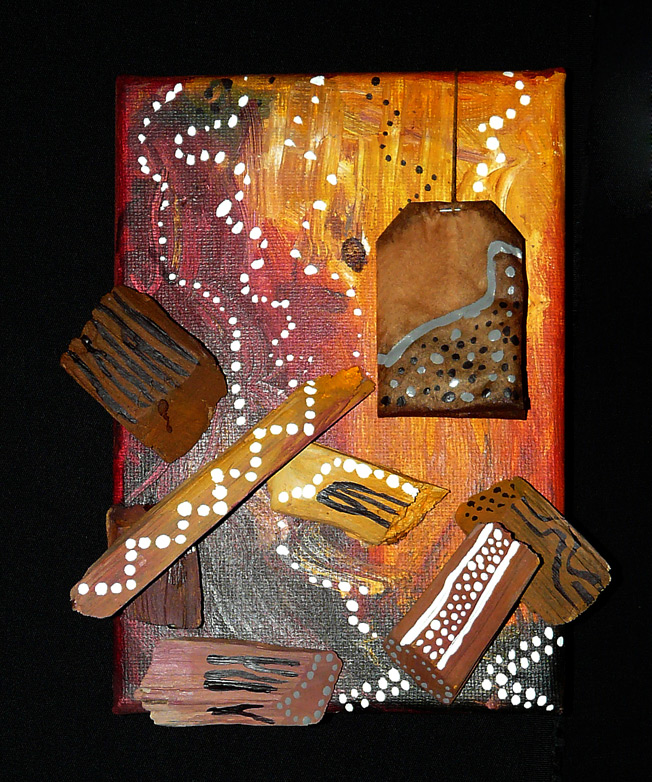 |
Fire Season, Mixed Media This small painting was done to encourage people to see the elements of aboriginal painting expressed in what we actually sea in bush fires; speckles of hot white ash and black ash. Textures of wood (or burning wood) are painted on actual wood. The painted teabag is to tie in my theme of the 'western dreamtime'. The teabags play an important role in these artworks, representing how this ancient brew brings we 'westerners' together as we escape momentarily from the issues of life, allowing us to day dream and be at peace. It is to also represent our Western culture and links back to our early origins of England. |
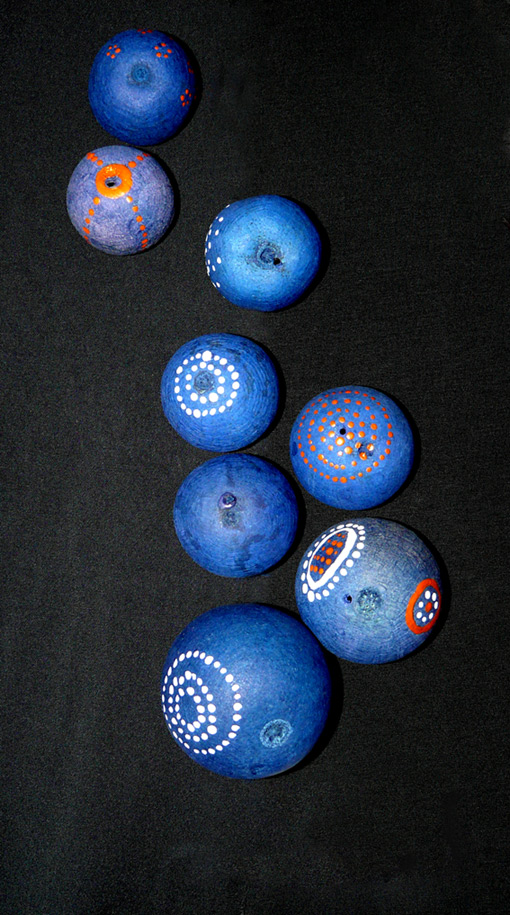 |
Rock Pools, Acrylic These blue painted native Australian nuts, are depicting the unusual life forms you can see in rock pools. In this we see stylised depictions of anenome's, chiton's, limpets, cunjevoi and various other shellfish/sea-life patterns. |
 |
Dreamtime Ezekiel’s Wheel Interpretation Outer to inner work: Chay Owphan, Ruach Chay Owphan, Acrylic The vision’s of Ezekiel had played a role in my process since the beginning of the year, tied in with my exploration with Isaiah’s vision and John’s vision in Revelations. My fascination was with how the spiritual landscape through the Hebraic records of time did change. The eyes from the wheel were transferred onto the creature’s body and the Spirit manifest Himself more conservatively as a lamp before God’s throne, etc. The titles of these artworks are in Hebrew (‘Spirit of the living creature in the wheel’), a possible indigenous Dreamtime perception of the spiritual landscape of Hebraic culture (different languages and different perceptions of the one heaven/spiritual landscape). |
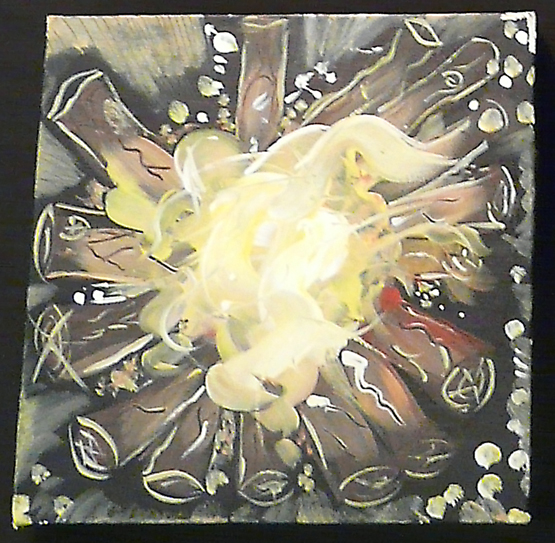 |
Fire Dreaming, Acrylic This was based on a vision I had this year and helped me theme my exhibition 'Dreamtime' exploring concepts of 'corroboree' and the use of teabags. I had the vision during a church tea. The Spirit is the fire, and we are the flaming sticks that come together (corroboree) for God to manifest His presence (fire, light). A hint of the landscape and Indigenous art seem to be in this painting. This was unintentional. I wanted to capture the magic of being around a fire, sparks and flaming coals expressed coming from it. |
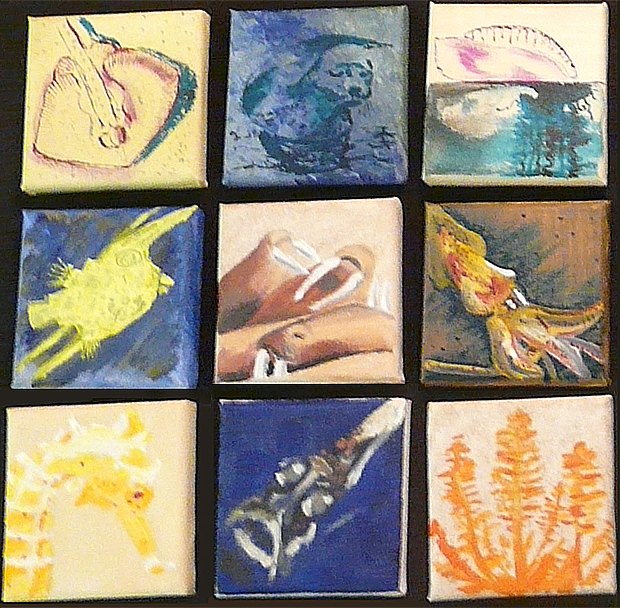 |
Marine Life Series, Mixed Media Midway through this year I was exploring the various life forms in the sea. Exploring form, texture and colour with the different creatures found in it, helped me appreciate the art forms of the seas. This helped me consider how I could approach my overall theme for my exhibition.
|
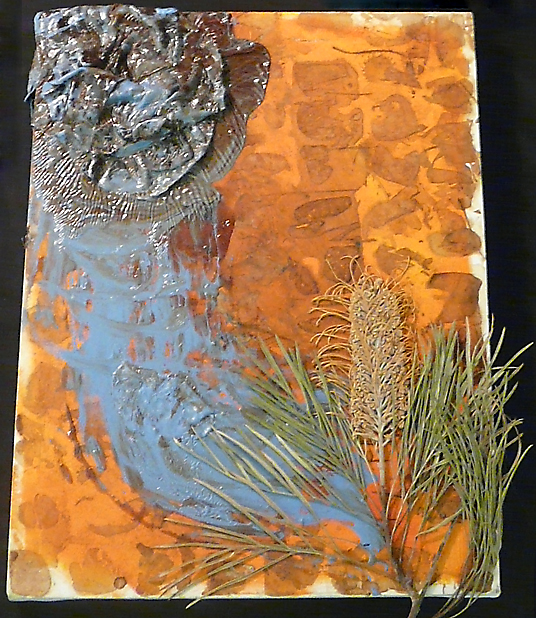 |
River Sun, Mixed Media The fiery backdrop is textured with teabag colour and form. I allowed the teabags for the wings to dry on the canvas. The massive blue sphere was the drying top-skin of a tub of blue oil paint. The dried-out flattened sprig of the bottle brush helps identify this artwork as portraying our surreal Australian landscape. This artwork is also encouraging the viewer to have a relationship with land and its spiritual component. The idea of having waters flowing from the sun was a beautiful concept I came up with in 2001 Karijini National Park, where I ventured up trickling falls in a canyon, that looked like gold. The sun reflected off the watery rock. I wanted to capture that mystical spiritual beauty this surreal landscape holds. Isaiah 43 also came to my mind when painting this, it talking about rivers forming in the desert places. |
 |
(Left to Right) Bottle Dust, Mixed Media Cracks And Bottles, Mixed Media In researching the flora of Australia, I realised that Aboriginal art was enspired by the abstract, surreal and alien-looking flower forms we have in Australia. These table-top artworks invite viewers to appreciate the natural artworks Australia provides - to make people see and value what the land offers. These artworks carry an essence of Australia by the odd placement of delicate cracks of earth and dried flattened bottlebrushes. These were placed on tea-tables. |
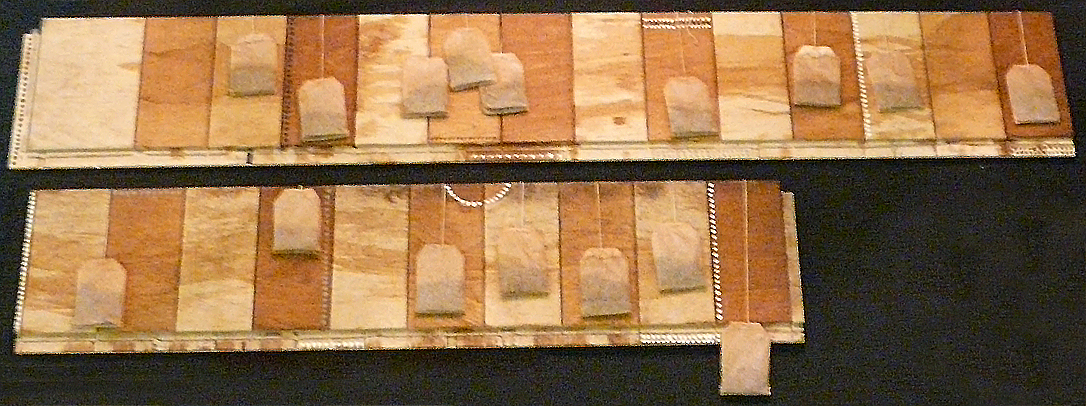 |
(Top to Bottom) Tea Dream, Mixed Tea Scape, Mixed Media These simple artworks are works that start suggesting to the viewer that they are entering into a dreamscape, tea being the way of escape through the subconscious to the spiritual. Having odd dots around the wooden frames suggests a transition from the subconscious to a 'dreamtime'. |
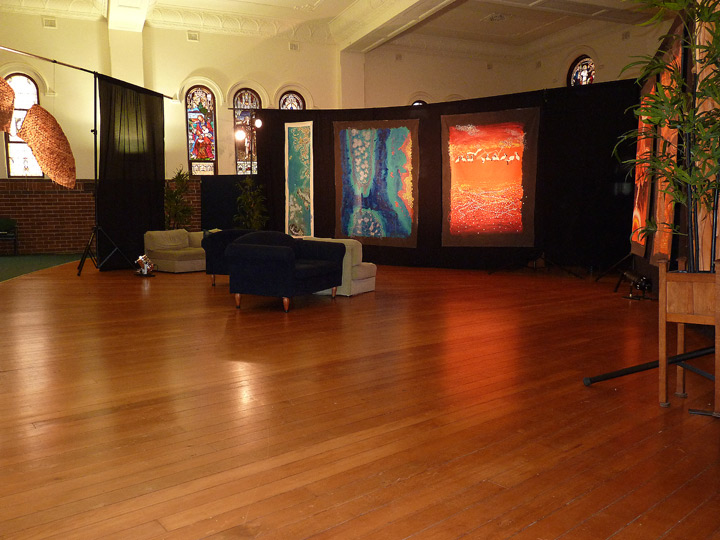
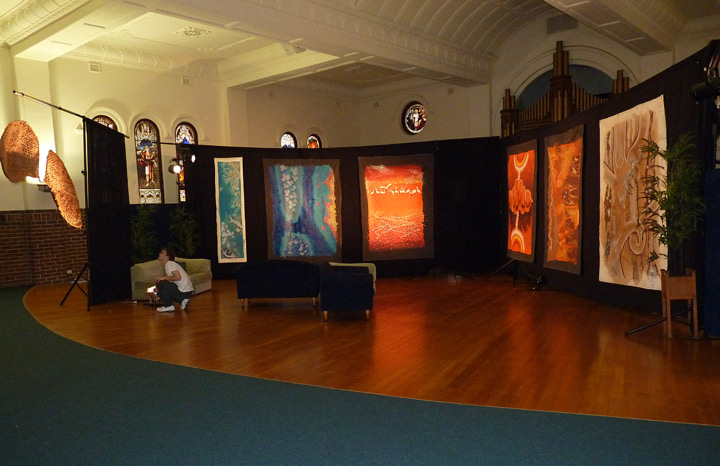
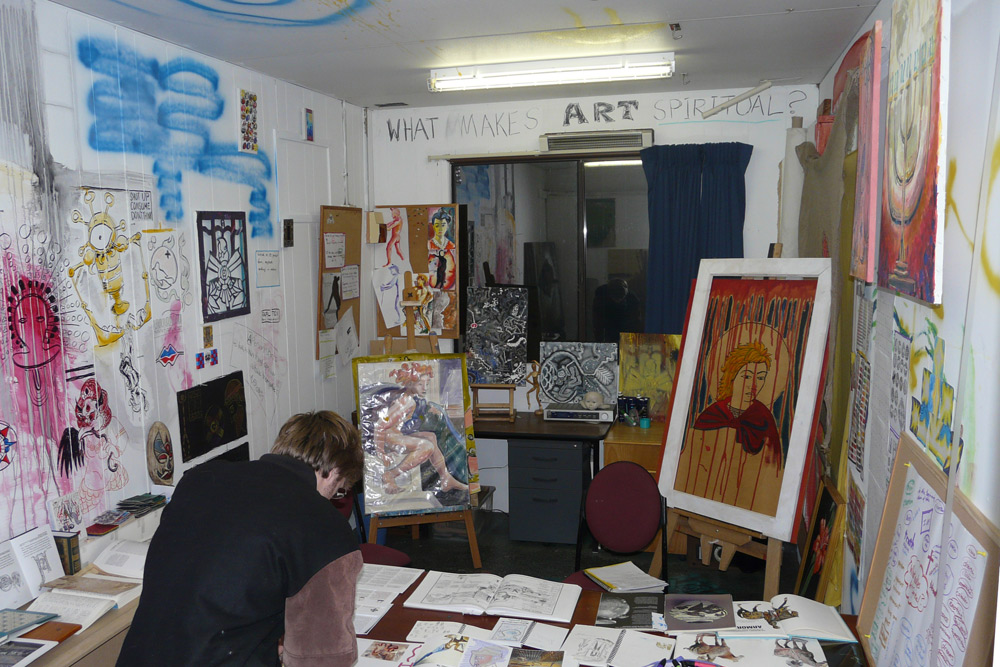
Continung quest - What makes art spiritual?